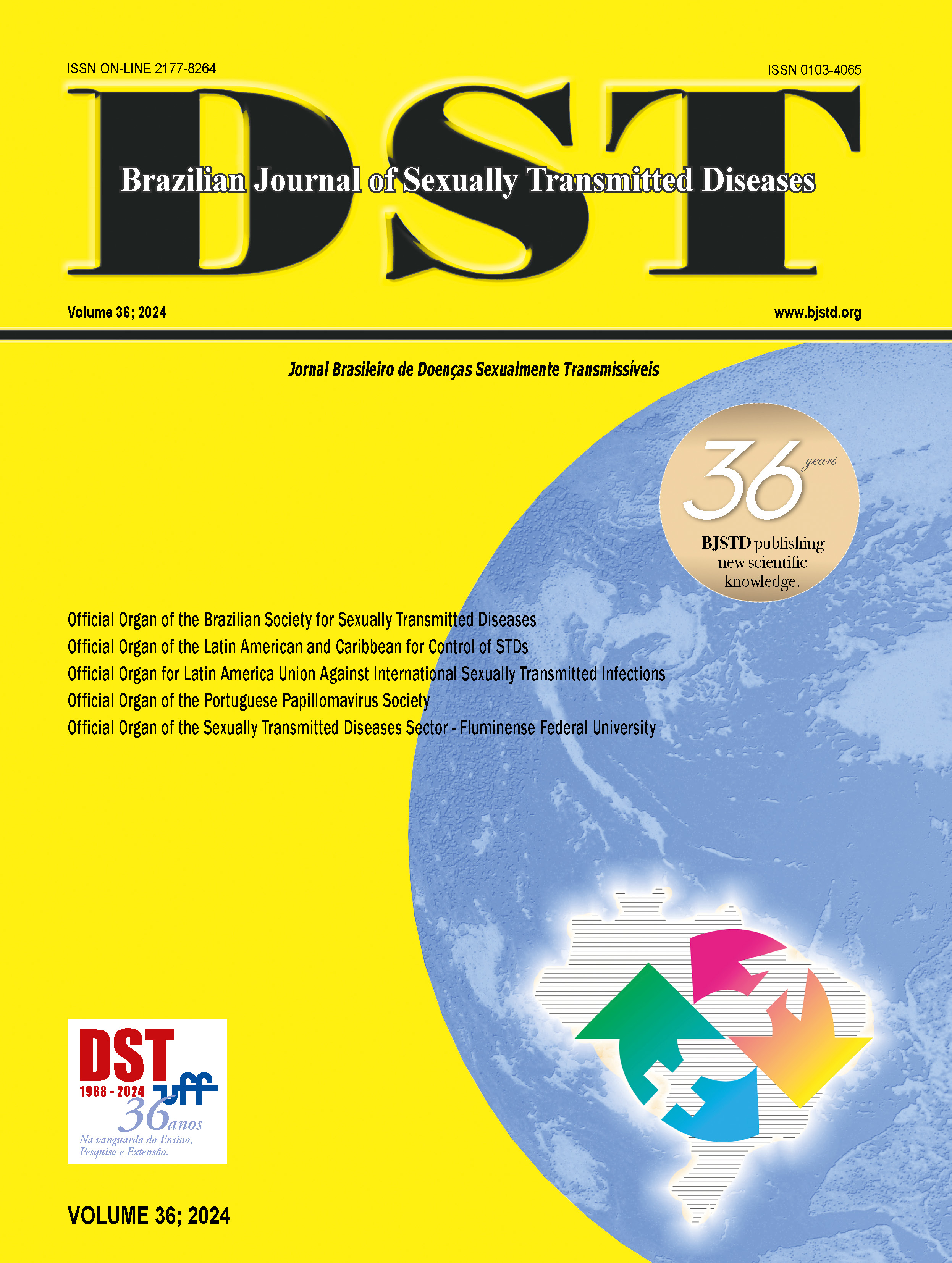Perfil de infecções sexualmente transmissíveis entre participantes de clínicas especiais (Suraksha) em um centro regional de doenças sexualmente transmissíveis Apex no norte da Índia – um estudo de cinco anos
DOI:
https://doi.org/10.5327/DST-2177-8264-2024361400%20Palavras-chave:
Uso de preservativo, Controle de doenças, Epidemiologia, HIV, População de alto risco, Educação do paciente, Triagem, Infecções sexualmente transmissíveis, Sífilis, População vulnerávelResumo
Introdução: As infecções sexualmente transmissíveis (IST) apresentam desafios de saúde globais e nacionais significativos, particularmente na Índia. Objetivo: Estimar a prevalência e as características das IST entre os pacientes atendidos na Clínica Suraksha do Centro Regional de doenças sexualmente transmissíveis (DST) Apex, Hospital Safdarjung. Métodos: Dados retrospectivos de janeiro de 2018 a dezembro de 2022 foram analisados estatisticamente utilizando Excel e Statistical Package for the Social Sciences (SPSS). O estudo inclui o exame para diagnóstico de diversas IST, como sífilis, HIV, gonorreia, clamídia, tricomoníase, candidíase, vaginose bacteriana, cancroide e herpes genital. A distribuição por gênero e os diagnósticos sindrômicos, incluindo corrimento vaginal/cervical e úlceras genitais, também foram considerados. Foram analisados encaminhamentos para Centros Integrados de Aconselhamento e Testagem para testagem de HIV. Resultados: Os resultados revelam uma carga substancial de IST, com 3,06% apresentando reatividade à sífilis, 1,74% testando positivo para HIV, 3,36% para gonorreia, 11,78% para clamídia, 1,05% para tricomoníase, 26,24% para candidíase, 9,97% para vaginose bacteriana, 7,80% para cancroide, 11,64% para herpes genital e 4,01% para outras infecções não IST. As interações dos participantes incluíram 34,36% de encaminhamentos para Centros Integrados de Aconselhamento e Testagem para testes de HIV. A distribuição por gênero mostrou 58,92% de participantes do sexo masculino e 40,94% do sexo feminino. Conclusão: Os diagnósticos sindrômicos, incluindo corrimento vaginal/cervical (21,22%) e verrugas genitais (8,00%), destacam condições prevalentes, necessitando de exames de rotina, detecção precoce e intervenções direcionadas para controle e prevenção eficazes de doenças. Estas conclusões sublinham a importância do rastreio integrado, da educação dos pacientes e de estratégias proativas para salvaguardar a saúde pública diante do aumento das taxas de IST.
Downloads
Referências
Agrawal N, Rana MM, Patel KB, Bapat N. Profile of reproductive tract infections among attendees of reproductive tract infection/sexually transmitted infection clinic in a tertiary care Institute of Ahmedabad, Gujarat. Indian J Community Med. 2019;44(1):62-3. https://doi.org/10.4103/ijcm.IJCM_32_18
Choudhry S, Ramachandran VG, Das S, Bhattacharya SN, Mogha NS. Pattern of sexually transmitted infections and performance of syndromic management against etiological diagnosis in patients attending the sexually transmitted infection clinic of a tertiary care hospital. Indian J Sex Transm Dis AIDS. 2010;31(2):104-8. https://doi.org/10.4103/0253-7184.74998
Parashar A, Gupta BP, Bhardwaj AK, Sarin R. Prevalence of RTIs among women of reproductive age group in Shimla city. Indian J Community Med. 2006;31:15-7. https://doi.org/10.4103/0970-0218.54924
Balamurugan SS, Bendigeri N. Community-based study of reproductive tract infections among women of the reproductive age group in the urban health training centre area in Hubli, Karnataka. Indian J Community Med. 2012;37(1):34-8. https://doi.org/10.4103/0970-0218.94020
Passos MR, Arze WN, Mauricio C, Barreto NA, Varella RQ, Cavalcanti SMB, et al. Is there increase of STDs during Carnival? Time series of diagnoses in a STD clinic. Rev Assoc Med Bras (1992). 2010;56(4):420-7. https://doi.org/10.1590/s0104-42302010000400014
Garland SM, Tabrizi SN, Chen S, Byambaa C, Davaajav K. Prevalence of sexually transmitted infections (Neisseria gonorrhoeae, Chlamydia trachomatis, Trichomonas vaginalis and human papillomavirus) in female attendees of a sexually transmitted diseases clinic in Ulaanbaatar, Mongolia. Infect Dis Obstet Gynecol. 2001;9(3):143-6. https://doi.org/10.1155/S1064744901000254
Murphy PA, Jacobson J, Turok DK. Criterion-based screening for sexually transmitted infection: Sensitivity, specificity, and predictive values of commonly used questions. J Midwifery Womens Health. 2012;57(6):622-8. https://doi.org/10.1111/j.1542-2011.2012.00228.x.
Goyal MK, Witt R, Hayes KL, Zaoutis TE, Gerber JS. Clinician adherence to recommendations for screening of adolescents for sexual activity and sexually transmitted infection/human immunodeficiency virus. J Pediatr. 2014;165(2):343-7. https://doi.org/10.1016/j.jpeds.2014.04.009
Brook G, McSorley J, Shaw A. Retrospective study of the effect of enhanced systematic sexually transmitted infection screening, facilitated by the use of electronic patient records, in an hiv-infected cohort. HIV Med. 201314(6):347-53. https://doi.org/10.1111/hiv.12020
Bala M, Mullick JB, Muralidhar S, Kumar J, Ramesh V. Gonorrhoea & its co-infection with other ulcerative, non-ulcerative sexually transmitted & HIV infection in a Regional STD Centre. Indian J Med Res. 2011;133(3):346-9. PMID: 21441694.
Sonkar SC, Wasnik K, Kumar A, Sharma V, Mittal P, Mishra PK, et al. Evaluating the utility of syndromic case management for three sexually transmitted infections in women visiting hospitals in Delhi, India. Sci Rep. 2017;7(1):1465. https://doi.org/10.1038/s41598-017-01422-y
Kumarasamy N, Balakrishnan P, Venkatesh KK, Srikrishnan AK, Cecelia AJ, Thamburaj E, et al. Prevalence and incidence of sexually transmitted infections among South Indians at increased risk of HIV infection. AIDS Patient Care STDS. 2008;22(8):677-82. https://doi.org/10.1089/apc.2007.0166
Choi J, Bahl D, Arora M, Xuan Z. Changes in self-reported sexually transmitted infections and symptoms among married couples in India from 2006 to 2016: a repeated cross-sectional multivariate analysis from nationally representative data. BMJ Open. 2021;11(10):e049049. https://doi.org/10.1136/bmjopen-2021-049049
Brahme RG, Sahay S, Malhotra-Kohli R, Divekar AD, Gangakhedkar RR, Parkhe AP, et al. High-risk behaviour in young men attending sexually transmitted disease clinics in Pune, India. AIDS Care. 2005;17(3):377-85. https://doi.org/10.1080/09540120412331299771
Downloads
Publicado
Como Citar
Edição
Seção
Licença
Copyright (c) 2023 Brazilian Journal of Sexually Transmitted Diseases

Este trabalho está licenciado sob uma licença Creative Commons Attribution 4.0 International License.












